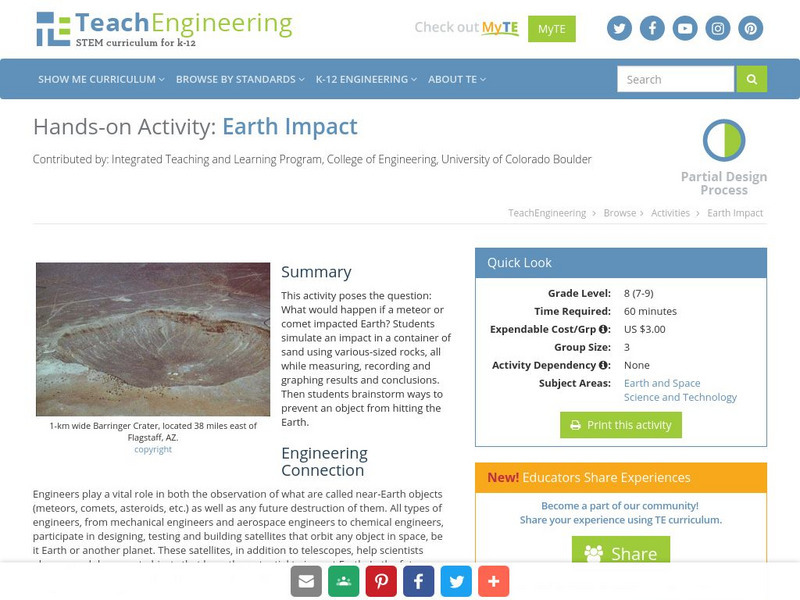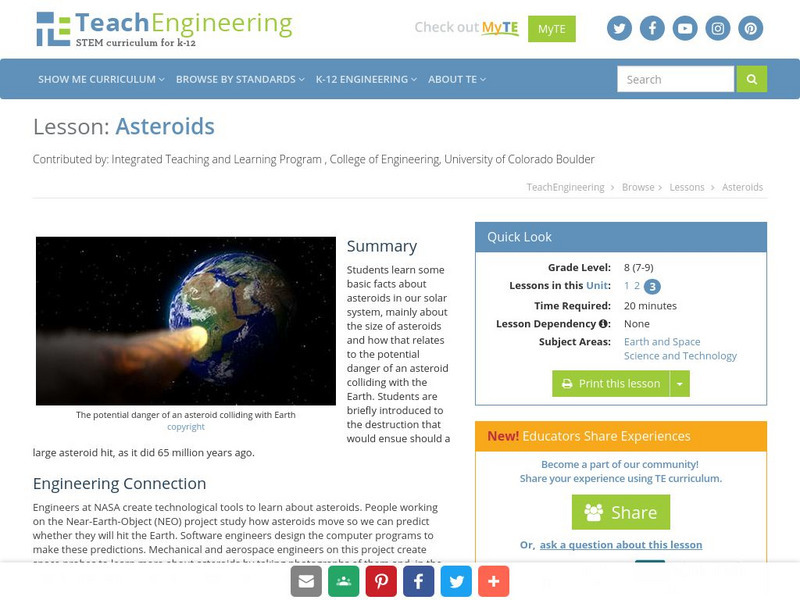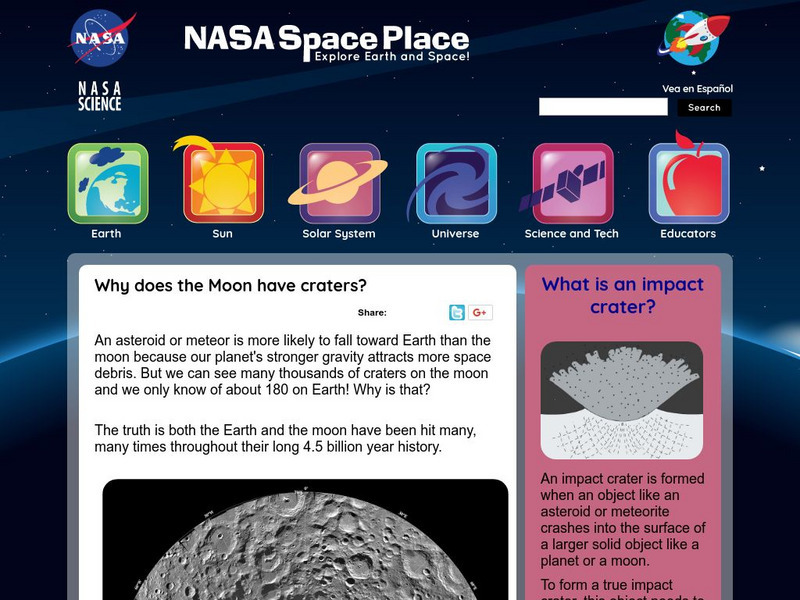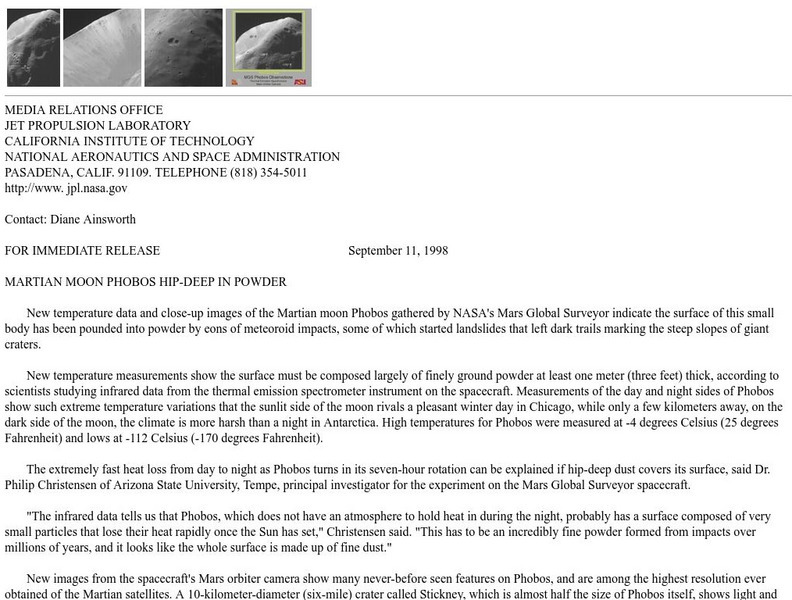Hi, what do you want to do?
Scholastic
Study Jams! Earth's Atmosphere
Earth's thick atmosphere plays a vital role in the ability of the planet to sustain life. Learn about the layers of the atmosphere and their properties, how the gases surrounding the earth help protect the planet, and a little about...
Curated OER
Space Science: Adventure is Waiting
These full-color handouts feature two activities. The first is a reading on comets, meteors, and meteoroids. Your space science learners will examine ten phrases and determine which of the three each characterizes. The second activity...
Curated OER
Edible Rocks, Munchy Meteorites
Students observe candy samples and attempt to match them to their descriptions. In this meteorite lesson, students are introduced to meteorite terminology with candy samples. They describe the candies in their own words and work together...
Curated OER
Asteroid, Comet, or Meteor?
In this asteroid, comet and meteor instructional activity, learners complete a chart by determining which of 8 given characteristics belong to asteroids, comets or meteors.
Curated OER
Asteroids
Students examine the different types of asteroids and how they enter the atmosphere. In this space lesson students use mashed potatoes to create an asteroid they can eat.
Curated OER
Meteor Monitor
Student's measure sporadic meteor activity. For this physics and astronomy lesson, 11th graders construct a dipole antennae, and build, test and wire a full wave diode rectifier between the dipole antenna and the laptop.
Curated OER
Meteor, Meteoroid, Meteorite: What's the Difference?
Students explore the difference between a meteor, meteorite and meteoroid. In this space science lesson, students first read information about these space bodies. Students make Comet Cookies and use them to model a meteor shower with a...
Curated OER
Asteroid, Comet, or Meteor?
In this asteroid, comet, and meteor graphic organizer worksheet, students compare and contrast asteroids, comets, and meteors as they mark the characteristics of each.
Curated OER
Space Search
For this space worksheet, students identify and locate vocabulary terms and names related to space. There are 26 words located in the puzzle.
Curated OER
Objects in the Solar System
Eighth graders define a planet by the orbit around the sun, have a large enough gravitational force to hold a sphere shape and needs to clear the neighboorhood of it own orbital zone. They describe comets, meteoroids, meteor, meteorites...
Curated OER
NASA Search
In this space worksheet, students identify and locate vocabulary terms related to NASA and space. There are 31 words located in the puzzle.
Curated OER
The Solar System
In this space worksheet, students identify and locate vocabulary terms related to the Solar System. There are 30 words located in the puzzle.
Georgia Department of Education
Ga Virtual Learning: Astronomy: The Earth
In this interactive tutorial students will learn what causes the seasons, diurnal cycles and how the constellations move through the sky. Learn we are able to see other planets and how astronomical events affected life on the Earth.
TeachEngineering
Teach Engineering: Earth Impact
This activity poses the question: What would happen if a meteor or comet impacted Earth? Students simulate an impact in a container of sand using various-sized rocks, all while measuring, recording and graphing results and conclusions....
TeachEngineering
Teach Engineering: Asteroids
Students learn some basic facts about asteroids in our solar system, mainly about the size of asteroids and how that relates to the potential danger of an asteroid colliding with the Earth. Students are briefly introduced to the...
Natural History Museum
Natural History Museum: Meteorites
As an online exhibit on meteorites, this site provides a series of topics on meteors answering questions such as what is a meteor, to providing information on types of meteors and studying meteors.
NASA
Nasa: Solar System Exploration
Enter our solar system to interact with the planets, moons, asteroids, meteors, and more. Investigate with NASA scientists and explore missions related to space exploration. Read facts, compare statistics, look through resources, and...
Lawrence Berkeley National Laboratory
Berkeley Lab: The Fruitful & Inventive Mind of Scientist Luis Alvarez
This article, reprinted from the fall 1979 LBL News Magazine, was written about Dr. Luis Alvarez and his part in the study of geological sediments and the great extinctions.
Scholastic
Scholastic: Study Jams! Science: Weather & Climate: Earth's Atmosphere
A video and a short multiple-choice quiz on the composition of and the layers in Earth's atmosphere.
NASA
Nasa: Space Place: Why Is the Moon So Scarred With Craters?
Find out about why Earth's moon is full of craters, and what happens to asteroids and meteors when they come into contact with Earth.
CK-12 Foundation
Ck 12: Plix: Orbital Motion: Distance
[Free Registration/Login Required] The meteor is orbiting one of the 3 planets in a circular orbit. Drag the point associated with each planet to the meteor to see its orbit around that planet.
NASA
Nasa Star Child: Star Child
StarChild from NASA defines and describes the Solar System in a simple and easy-to-understand manner. The website is broken down into two versions for the student, grade school and junior high.
NASA
Nasa: Martian Moon Phobos Hip Deep in Powder
This press release from NASA, based on data from the Mars Global Survey/Mars Orbiter Camera describes Mars' moon Phobos. Included are small thumbanil images that link to more detailed GIF files.




























